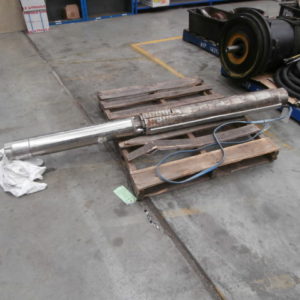Ask the Experts: Protecting Your Bore Pump from Failure
More often than not, premature pump failure tends to be caused by two main reasons being abrasion/corrosion to both the pump and motor and outright motor failure. Here, we look at the most common ways your bore pump can fail and how to minimise the risk of this happening.
All pumps are not equal in their makeup. Knowing the fluid and selecting the right grade metal up front gives you the best chance to have a sustained period of stress free pumping. However even assuming you have selected the right pump there will be outside factors which will affect your pump life.
Iron contamination
 Iron bacteria and iron oxide are two of the most common enemies of borehole pumps. Contaminants can accumulate and clog the pump’s components as well as corroding parts, leading to complete system failure over time. If there are signs of reddish sludge or threads within the system, then cleaning and disinfecting the system can kill off iron bacteria. An in-line filter can also help to capture and contain contaminants, while liquid solutions can assist in clearing and flushing deposits.
Iron bacteria and iron oxide are two of the most common enemies of borehole pumps. Contaminants can accumulate and clog the pump’s components as well as corroding parts, leading to complete system failure over time. If there are signs of reddish sludge or threads within the system, then cleaning and disinfecting the system can kill off iron bacteria. An in-line filter can also help to capture and contain contaminants, while liquid solutions can assist in clearing and flushing deposits.
Motor failure
One of the most common causes of submersible pump failure is motor failure, which is normally associated with overheating in the motor itself. As the pump and motor combination sit in the bore, if there is inadequate cooling provided by the water passing the motor it will overheat and die.
As a minimum, you need 0.15m/s velocity of water passing the motor to ensure adequate cooling. Often the water level will drop below this recommended level if you don’t have a shroud on the pump/motor and you are pumping at a lower than expected flow. This typically is experienced as a result of a seasonal drop in the ground water level and as a result the pump is forced to deliver less water than it was designed to.
A motor should only be started a certain number of times per day and if you consistently exceed the recommended number of starts per day, you will shorten the motor life So if your pump is starting/stopping on auto due to low water levels you may find you will exceed the recommended number of starts and the motor will be damaged. The below table provides an indication of the maximum number of times your motor should be started per day based on the motor diameter, before damage will occur to the motor.
| Motor Diameter | Min start per year |
Max starts per hour |
Max starts per day |
Max water temp |
| 100mm | 1 | 100 | 300 | 40°C |
| 150mm | 1 | 15-30 | 300 | 60°C |
| 200mm | 1 | 10 | 240 | 60°C |
It is also important to keep an eye on your incoming power supply, as a drop in voltage will typically result in an increase amperage draw which again means a higher motor operating temperature.
Adequate water in the bore
Given a submersible pump by definition is immersed in water you could be forgiven for assuming there will be no limits to performance relating to the suction conditions and cavitation. However there will be a limit to how far you can draw down the water in the bore before it impacts performance. Your pump will have a NPSH required figure which sets your drawdown limit. If in doubt check with us so we can advise.
Pressure gauge
A pressure gauge is a very useful tool in helping to determine a change in application and hence a potential deterioration in your pump performance. When you set up the pump initially, make a note of the pressure because any subsequent change to this will indicate a change in pumping conditions.
If your pump is not performing and you do need to contact a professional, knowing some simple facts about your pumping system in terms of pressure, flow, pump depth, power supply etc. will make a big difference in troubleshooting the problem.
If you are looking for service and / or upgrade your bore pump, contact the team at Malcolm Thompson Pumps about our submersible bore pumps and bore pump packages.










